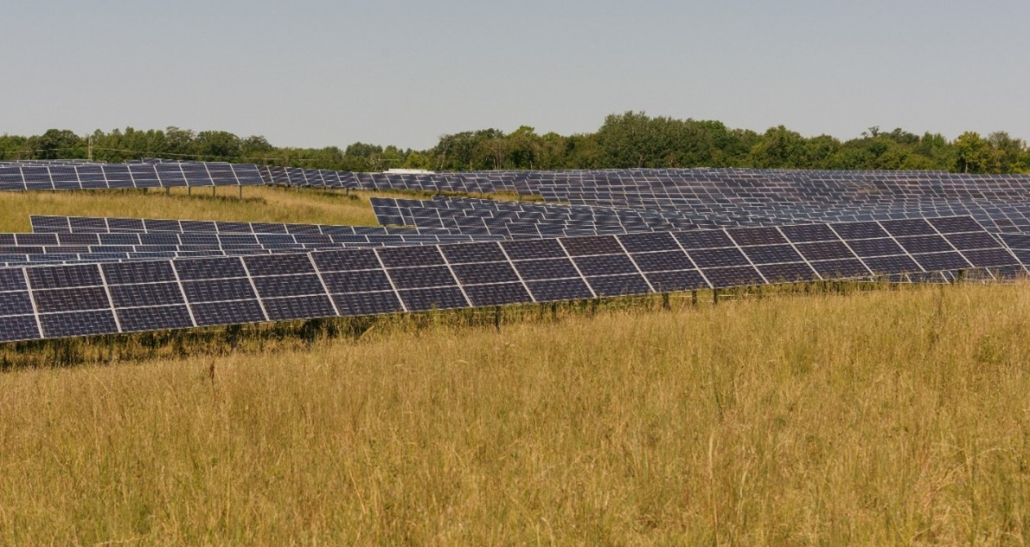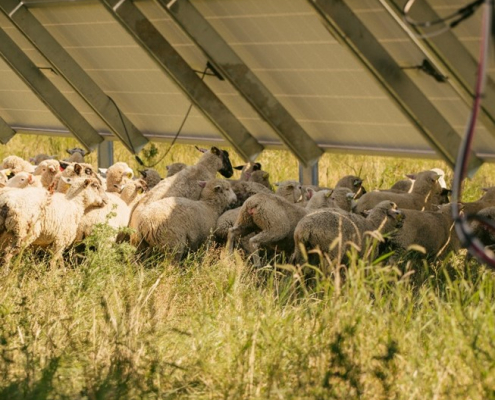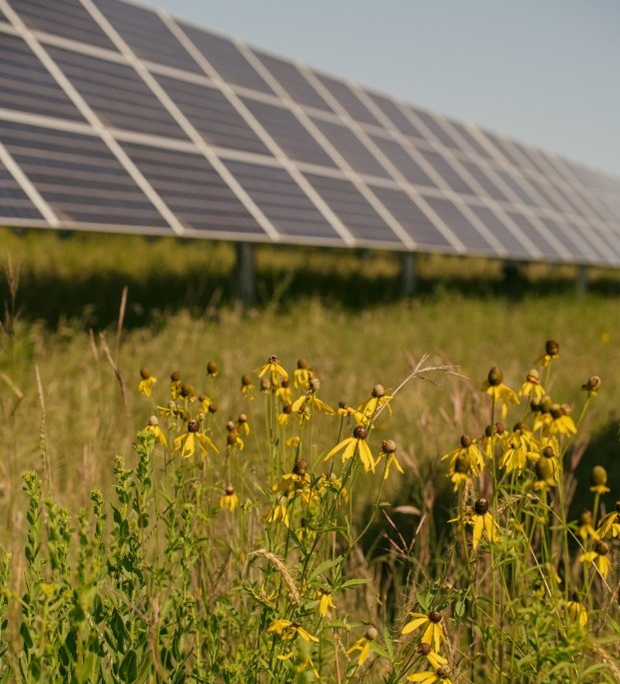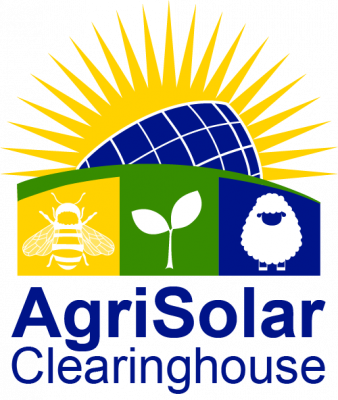Agrivoltaics is a concept in which a piece of land is simultaneously used for both energy and food production by mounting photovoltaic modules at a certain height above (or in between strips of) agricultural land. A local and system-level incorporation of water management is imperative to the sustainable implementation of agrivoltaics. Water raining on the module can be gathered and used for distinct purposes: groundwater recharge, crop irrigation, and cleaning and cooling of the PV modules. This research provides an initial overview of positive and negative impacts for each water use concept and outlines issues that should be taken into consideration and the potential for research and development. Various Managed Aquifer Recharge (MAR) technologies are a way to clean and store the water periodically in an underlying aquifer. Irrigation increases yield within the plant level and therefore increases the system’s output. Thanks to the power supply generated by the PV modules, high-tech irrigation systems can be implemented in agrivoltaic systems; the special adaption of irrigation systems to agrivoltaics poses significant potential for research and development. Meanwhile, the necessity, i.e., profitability of cleaning and/ or cooling PV modules depends on local environment and economic factors. Several cleaning techniques have been developed to mitigate soiling, ranging from manual cleaning to fully automatic cleaning systems. In agrivoltaics systems, the soiling risk can increase. Semi-automatic systems seem to have the greatest potential for agrivoltaics, because they can be used with farming equipment. Multiple cooling techniques have been developed to decrease cell temperature to increase power output, with some of them involving water. Water flowing over the module surface is a promising a promising cooling technique for agrivoltaic applications. Attaching a perforated tube to the upper edge, the entire module can be covered in a thin film of water which cools very effectively (while also cleaning the surface). A closed-circuit system could be created involving the technical components used for rainwater harvesting. The economic feasibility of cooling panels in agrivoltaic systems needs to be investigated. In certain locations, rainwater-harvesting could also be relevant for ground-mounted PV systems.
Tag Archive for: Agrivoltaics
Australian Researchers Develop Solar Panels Optimized for Agrisolar
“University of New South Wales researchers have teamed up with Tindo Solar to develop a line of semi-transparent modules, specialized for agrivoltaic cropping, which will use nanoparticles tuned to capture different parts of the light spectrum. ‘There is evidence you don’t need the full spectrum and some plants will work even better if you provide them with only part of the spectrum,’ project lead and UNSW Associate Professor Ziv Hameiri tells PV Magazine Australia. Crucially, he says, the project will also open a line between farmers, solar researchers and industry, creating the potential for mutual benefits.” – PV Magazine
Agrisolar Operations Show That Solar Does Not Compete with Farmland
“In short, Agrivoltaics is a rapidly growing branch of the energy transition. It is being applied to all manner of crops across the world. All kinds of benefits are emerging, with China even using it to reverse desertification. Not only is it expanding clean energy production, it is providing a vital second income stream for farmers. Banning it would cut off a really important opportunity for Britain’s farmers, at a time when rural poverty is a real issue.” – Green Peace
Oregon State Develops 5-Acre Agrisolar Project
“Oregon State University has started construction on a $1.5 million research project to optimize dual-use, co-developed land hosting solar photovoltaic arrays and agriculture. The five-acre Solar Harvest project is located at Oregon State’s North Willamette Research and Extension Center in Aurora, Oregon, 20 miles south of Portland. The 326-kW project is the result of a partnership between Oregon State and the Oregon Clean Power Cooperative, which developed the solar array and financed the construction of the solar array.” – Solar Power World
This guide provides an overview of the federal investment tax credit for residential solar photovoltaics (PV). The federal residential solar energy credit is a tax credit that can be
claimed on federal income taxes for a percentage of the cost of a solar PV system paid for by the taxpayer.

Lake Pulaski is an agrivoltaic solar power plant site developed by Enel Green Power that spans over 68.2 acres in Buffalo, Minnesota. This site is one of 16 developed for the Aurora Distributed Solar LLC project in 2017, supporting pollinators, grazing, and an apiary. The layout consists of 34,668 panels at 315 watts each, spanning over 500 individual arrays. The total plant system size is 10.92MW (dc). Each panel has a SolTech single, horizontal axis tracker to follow the sun path and optimize production. This tracker was chosen over the more standard axis-pole trackers due to their ability to allow curves in the array installation to accommodate the rolling landscape. The developers strived to install the system with minimal land disturbance to maintain the landscape and reduce excavation, thus allowing the panels to move with the rolling hills. Panel height was design to be approximately 2.5 fee from the ground at the maximum tilt angle of 45o to allow grazing sheep to pass under without harm to sheep or panels. This sets the total height of each array at a maximum of 10 feet.


The landscape is grazed once a year near the end of September for one month to reduce the need for mowing, save on labor and gas, and maintain a healthy soil chemistry. Graduate students at Temple University in Pennsylvania are conducting studies on the benefits of grazing, such as soil composition, a reduced mowing, and a reduction in spraying for weeds. Eight of the 16 Aurora project sites are grazed for research purposes. Occasional mowing is required if the area has a high-growth year. Minnesota Native Landscapes (MNL) developed the original native seed profile to help promote pollinator activity under the panels. The final seeding was completed by Westwood Professional Services. MNL also maintains the pollinator and native landscape. Bare-grounded spraying is used to kill off unwanted invasive species, such as thistle. These areas are then fenced off to prevent wildlife and sheep in the area. Soil samples are taken from sprayed and mowed areas for research. Lake Pulaski also promotes the bee population by allowing bee farmers to move their hives next to the site to help pollinate the area and grow healthier bees.



Lake Pulaski is not without maintenance needs. The enormity and complexity of the site requires technicians, plant experts, landscapers, and sheep farmers to ensure that the site function as designed. Enel Green Power does most of the technical maintenance, while MNL sprays and maintains the plants. The SolTech trackers require slightly more maintenance than pole trackers, and they can go offline due to storms, sheep knocking the sensors, and other natural causes. Background research is being conducted by ENEL to determine whether the tracking system is worth the extra maintenance. At the end of the site’s service life, which is typically 25 years, the developers hope to decommission the system and return the land to agriculture with richer soil than the gravel alternative and unharmed adjacent landscapes. The research from this site will help quantify the benefits that agrivoltaics can bring to both solar development and agriculture industries.
Jack’s Solar Garden’s 2022 season caught on film by documentarian Chad Weber of Longmont, Colorado. Hear from our people, see the work that has been done, decide how the future of solar development on America’s farmland.
Solar Projects Increase Tax Revenue in North Carolina
“Proposed large-scale solar facilities continue to draw opposition in North Carolina from critics who argue that swaths of panels are blights on the landscape and threaten farms in a state where agriculture is the leading industry. But those facilities have become a financial boon to local communities, particularly in rural areas with limited sources of tax revenue, a newly released study from the N.C. Sustainable Energy Association found.” – Greensboro
Dutch Research Studies Agrisolar
“During a four-year pilot project, Dutch independent research organization TNO, in collaboration with Vattenfall and Aeres University of Applied Sciences (UAS), is developing a sun-tracking algorithm that monitors various factors, such as crop yield, energy yield and the effects of herb strips, weather forecast, energy price and soil condition.” – Vattenfall
Small Farms in Maine are Good Candidate for Agrivoltaics
“Maine’s prevalence of small farms with low-lying, hand-harvested crops makes the state a good candidate for blending solar energy and food production on the same land, but farmers may not take the risk without funding for pilot projects.
Maine may be uniquely positioned for this emerging field, known as agrivoltaics or dual-use solar. Nationally, most successful projects so far have involved extras like solar grazing or pollinator habitat alongside panels at small farms with low-lying, hand-harvested crops — precisely the type of farms that dominate much of Maine’s agricultural sector.” – Energy News
In this document, the Great Plains Institute (GPI) identified existing permitting practices and standards for solar development in the five PV-SMaRT case study states (New York, Georgia, Minnesota, Colorado, and Oregon) and other states across the nation. GPI then completed a “barriers and opportunities” assessment of existing practices to identify opportunities for reducing solar development soft costs and compliance costs, while maintaining or improving water quality outcomes.
The Power of Shade in Agrivoltaics
“The sun’s energy feeds grazing fodder and crops side-by-side with solar panels. ‘For farmers, it’s a two-income stream,’ said Brad Heins, professor of animal science at the University of Minnesota. That might mean planting crops that thrive in the shade cast by the panels. Or, in Heins’ case, it can mean cooling cows in the panels’ shade rather than resorting to expensive fans in a barn.
Heins and his colleagues are at the cutting edge of this new field (agrivoltaics), but they aren’t alone. There are hundreds of agrivoltaics projects underway in the US. Some work better than others, and some may wind up not working at all. But the best will lead to a greener and more profitable rural America that embraces renewable energy as an asset.” – The Washington Post
Agrivoltaic Site Under Construction in Oregon
“Construction is underway on a $1.5 million project that will allow Oregon State University researchers to further optimize agrivoltaic systems that involve co-developing land for both solar photovoltaic power and agriculture. The five-acre Solar Harvest project is located at Oregon State’s North Willamette Research and Extension Center in Aurora, Oregon, 20 miles south of Portland. It is the result of a partnership between Oregon State and the Oregon Clean Power Cooperative.
The problem with agrivoltaics research to date, Higgins said, is that it has occurred using solar arrays designed strictly for electricity generation rather than in combination with agricultural uses, such as growing crops or grazing animals. The solar array at the North Willamette Research and Extension Center is designed specifically for agrivoltaics research, with panels that are more spread out and able to rotate to a near vertical position to allow farm equipment to pass through, Higgins said.” – Oregon State University
Agrivoltaics is Shown to be a “Win-Win” for Food and Energy
“’With the right investment, innovation and robust collaboration, agrifood systems could become one of the world’s most hopeful solutions to climate change, as well as reduce poverty and provide nourishment for all,’ says Sean de Cleene, head of the Food Systems Initiative at the World Economic Forum (WEF).
‘The hallmark characteristic of agrivoltaics is the sharing of sunlight between the two energy conversion systems: photovoltaics and photosynthesis,’ says Jordan Macknick, lead energy-water-land analyst at the US National Renewable Energy Laboratory. ‘It essentially mimics what humans have been doing for hundreds of years with agroforestry – think shade-grown coffee – intentionally creating partial shade to create multiple layers of agricultural productivity on the same piece of land.’” – Energy Monitor
This resource is an overview of the Photovoltaic Storm Water Management Research and Testing (PV-SMaRT) project, which seeks to develop and disseminate research-based, solar-specific resources for estimating storm water runoff at ground-mounted PV facilities as well as storm water management and water quality permitting best practices.
Solar Power and Crops Grow Together in the Midwest
“Farmland is well suited for solar development of all kinds, for the same reasons it’s good for growing crops — it’s largely flat, drains well and gets lots of sun. Grazing land for animals like sheep can also be a good fit for solar. But what makes these Purdue research panels different is that they haven’t taken farmland out of production — they’re built over top of the corn itself.
Researchers want to see how the co-location strategy could be a salve to a growing strain between solar and farming in the Corn Belt — where residents and towns are pushing back on what they see as industrialization in rural communities. That includes communities in Wisconsin, where University of Wisconsin-Madison researchers are working with Alliant Energy to pursue similar research on university-owned land near Stoughton.” – The Journal Times
Renters in California Will Have Access to Community Solar
“Following Governor Gavin Newsom’s signature, California passed AB 2316, the Community Renewable Energy Act. The law creates a community renewable energy program, including community solar-plus-storage, to overcome access barriers for nearly half of Californians who rent or have low incomes.
A new market for residents to opt into renewable energy contracts opens in California following Gavin Newsom’s signature on the Community Renewable Energy Act. The law will now be evaluated and implemented by the California Public Utilities Commission.” – PV Magazine
Roughly 26 Million Acres Needed to Reach Zero-Carbon Goals
“By dedicating about 1% of the country’s land to solar energy—an area roughly the size of Kentucky—we could enable the nation to power itself with zero carbon emissions. Assuming fossil fuel and biomass energy would be replaced with green energy, it would take approximately 13 million acres of land to power today’s grid solely from solar facilities. It should be noted, however, that this amount would likely need to double to account for energy storage, electric vehicle (EV) charging stations, and the necessary increase in electrical infrastructure. But by dedicating about 26 million acres or 1% of the country’s land to solar energy—an area roughly the size of Kentucky—we could enable the nation to power itself with no carbon emissions.” – PV Magazine
